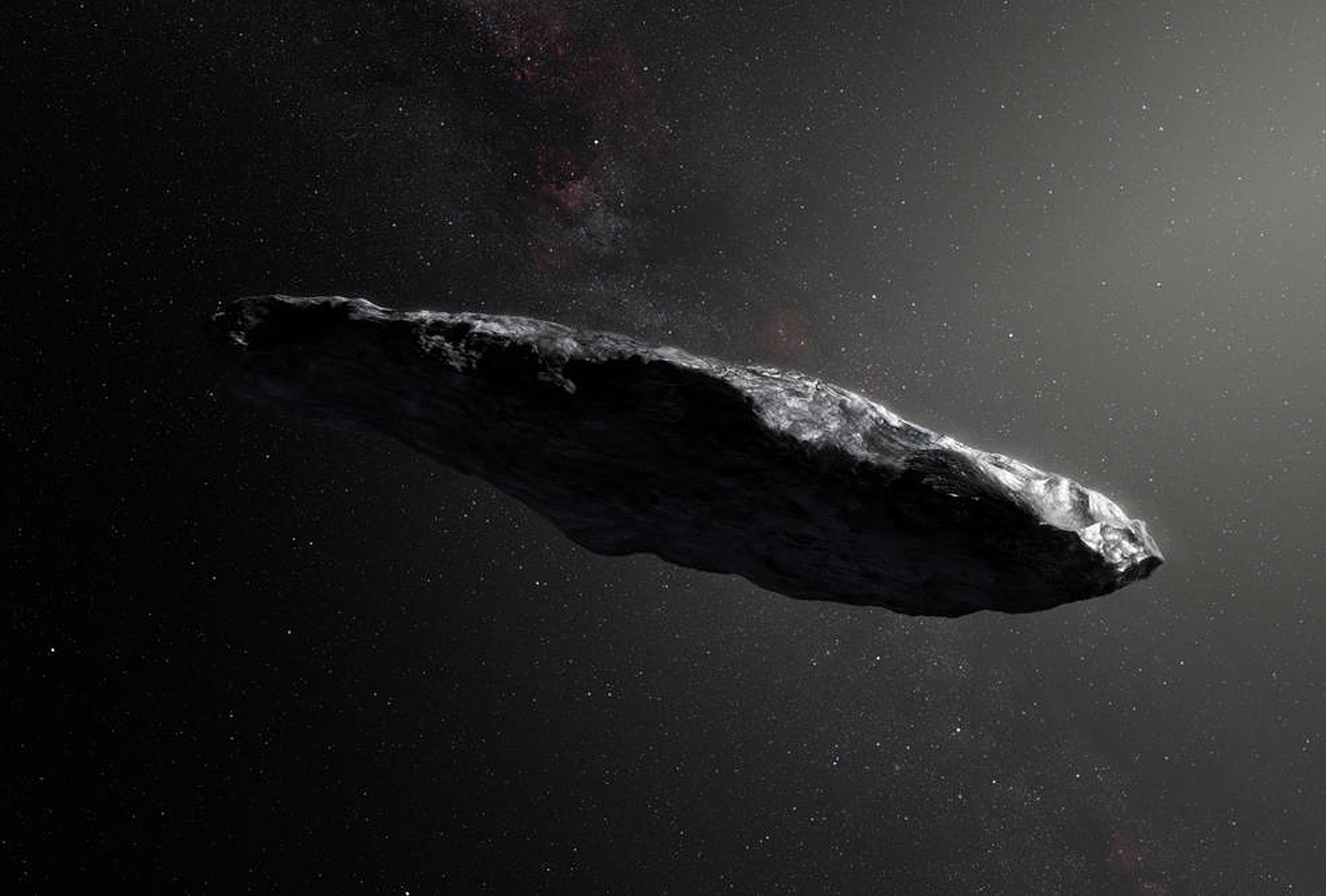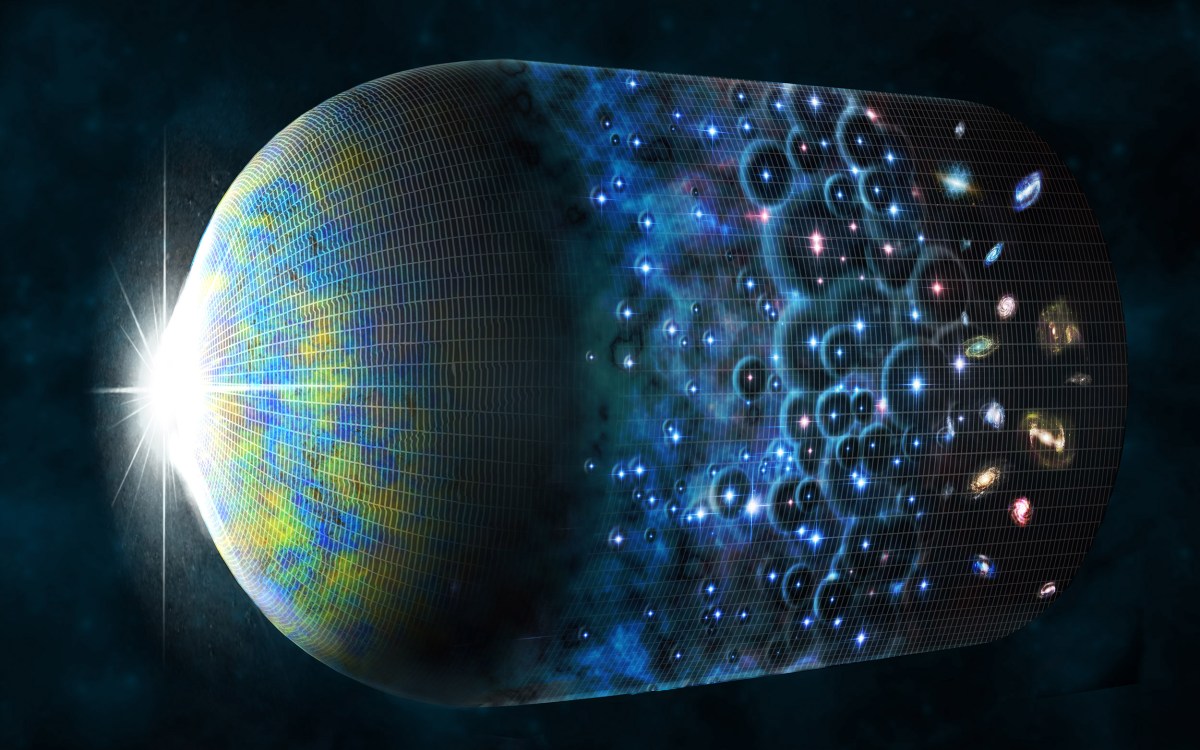
Artist’s rendering of ‘Oumuamua, the first known interstellar object to pass through our solar system.
European Southern Observatory/M. Kornmesser
Something weird this way comes
Harvard researchers see alien potential in mysterious object
Is the interstellar object known as “‘Oumuamua” a sign of extraterrestrial life? Avi Loeb, chair of Harvard’s Astronomy Department, isn’t surprised that his idea has drawn skepticism. All the same, he notes, progress begins with an open mind.
“This is how science works,” said Loeb. “We make a conjecture … and if someone else advances another explanation, we will compare notes and the next time we see an object of this type we will hopefully be able to tell the difference. That’s the process by which science makes progress.”
Loeb, also the Frank B. Baird Jr. Professor of Science, collaborated with postdoctoral fellow Shmuel Bialy on a paper suggesting that ‘Oumuamua may be a lightsail created by an alien civilization.
“When I first heard about ‘Oumuamua, this idea was in the back of my mind,” Loeb said. “So I approached Shmuel and said, ‘Let’s see whether sunlight can push this’ … because there was nothing else I could think of which could account for our observations, because this object is weird. So, my approach was to follow the maxim of Sherlock Homes — ‘When you have excluded the impossible, whatever remains, however improbable, must be the truth.’”
An alternative to traditional rocket propulsion, lightsails are propelled by radiation from the sun or from lasers. Calculations by Loeb and Bialy show that for solar radiation to push ‘Oumuamua, it must have an unusual geometry — tens of meters in size, but less than a millimeter thick.
In their paper, published this month in The Astrophysical Journal Letters, Loeb and Bialy advanced two possibilities for the object’s origins — that it is debris from a now-defunct craft tumbling through the galaxy, or that it was launched as a sort of reconnaissance probe from elsewhere in the galaxy.
While he acknowledged that other astronomers — including the researcher who discovered ‘Oumuamua — have dismissed those ideas, Loeb said such debates are an important part of the scientific process. And while alien life may once have been strictly science fiction, Loeb pointed to a growing body of evidence suggesting we’re not alone.
“We know a quarter of all the stars in the galaxy have planets in the habitable zone of their host star … so to me it’s not impossible that there may be life elsewhere,” he said.
“We know a quarter of all the stars in the galaxy have planets in the habitable zone of their host star … so to me it’s not impossible that there may be life elsewhere.”
Avi Loeb, chair of Harvard’s Astronomy Department, pictured below

Photo by Olivia Falcigno
First spotted just over a year ago by astronomers in Hawaii, ‘Oumuamua, whose name translates to “messenger from afar arriving first,” immediately captured scientists’ imaginations because it was the first known interstellar object to pass through the solar system. The mystery around the discovery quickly grew.
For starters, Loeb said, its reflection of sunlight suggested that its shape was much more elongated or flattened than any known asteroid or comet, and its motion indicated that it originated from the so-called “local standard of rest” obtained by averaging the random motions of all nearby stars. Fewer than one in 500 local stars moves as slowly in that frame, Loeb said.
What’s more, if ‘Oumuamua originated from a population of similar objects on random trajectories, its discovery would require the production of a thousand trillion such objects per star in the Milky Way — far more than the theoretical calculations Loeb and colleagues performed.
More like this
By far the most intriguing observation, Loeb said, suggested that ‘Oumuamua was not just accelerating, but deviating from its expected trajectory.
“The deviations aren’t large, only about one-tenth of a percent, but nevertheless that is significant,” Loeb said. “The question is what is making it deviate. We have seen deviations of this magnitude in comets when they experience outgassing as ice is warmed by the sun, but there is no cometary tail around ‘Oumuamua, and we don’t see its spin changing as we would with outgassing … so it occurred to me that this may be due to radiation pressure from the sun.”
The notion of using a solar sail to move across vast distances isn’t all that unusual, Loeb said.
In 2010, a Japanese spacecraft dubbed IKAROS demonstrated the first successful use of the technology. Loeb is the chair of the advisory board for the Breakthrough Starshot project, which aims to launch a solar-sail-driven probe to the nearest star system.
“It’s possible that, once a civilization reaches a certain maturity technologically, that this is a very common technological solution,” Loeb said. “A rocket is limited to a certain speed … because you are carrying the fuel with you. But if you are using light to push yourself, you’re not limited in the same way.”
Today, ‘Oumuamua is too far away to allow definitive answers on the questions raised by Loeb and other astronomers, and moving too fast to be chased down by probes launched from Earth. Loeb hopes that the next such opportunity will end with more answers.
“My hope is that the next time around, when there is an object like this, people will be intrigued, and … we will do everything we can to figure out what it is,” he continued. “It may well be that it’s a natural object, and if it is, I would argue that it has so many peculiar features that we should understand where it comes from, and we will learn something new from it. But until then, all possibilities should be on the table.”







